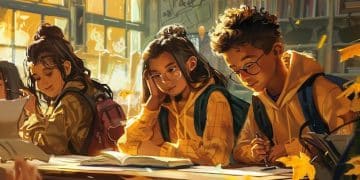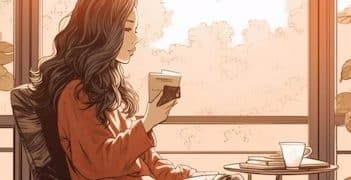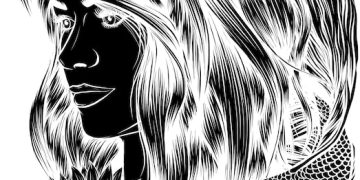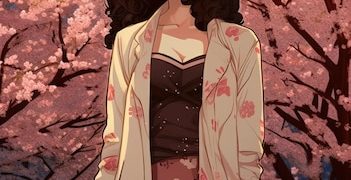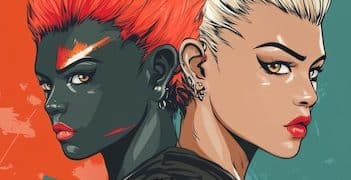Unveiling the Allure of Josei Manga: A Deep Dive

Josei manga, unlike its shojo counterpart aimed at younger girls, delves into the complexities of adult life, relationships, and societal issues, offering a more mature and nuanced perspective on romance, drama, and everything in between.
Delve into the captivating universe of josei manga, a genre tailored for adult women that explores mature themes and complex character dynamics. Leave behind the teenage fantasies and embark on stories that mirror the realities of work, love, and self-discovery.
What is Josei Manga? Unveiling the Genre
Josei manga, often translated as “woman” manga, is created for a demographic of older female readers. It diverges from shojo manga, which primarily targets younger girls, by showcasing more realistic scenarios and tackling complex emotions.
Let’s explore what makes this genre unique, its target audience, and how it differentiates itself from shojo.
Defining Characteristics of Josei Manga
Josei manga typically features relatable characters navigating the challenges of adulthood. These characters often grapple with issues such as workplace struggles, romantic relationships gone awry, and the search for personal identity.
The art style in josei manga varies, but it tends to be more refined and less idealized than in shojo. Realistic body proportions and mature facial expressions are common.
Target Audience and Themes
The primary audience for josei manga is women aged 18 and older. This demographic seeks stories that resonate with their own experiences and offer a more mature perspective on life. Common themes include:
- Workplace Drama: Stories centered around office politics, career aspirations, and the challenges of balancing work and personal life.
- Complex Relationships: Exploration of romantic relationships, marital issues, and the evolving dynamics between family members.
- Self-Discovery: Journeys of self-acceptance, personal growth, and overcoming societal expectations.

Unlike shojo manga, which often relies on fairytale romances and idealized scenarios, josei offers a glimpse into the messiness and complications of real life.
In conclusion, josei manga is a genre that speaks to the experiences and desires of adult women, offering realistic narratives and complex characters.
Key Differences Between Josei and Shojo Manga
While both josei and shojo manga are aimed at female audiences, significant differences exist in their themes, art styles, and overall narrative approaches.
Understanding the nuances between these two genres is crucial for readers looking to explore the world of manga beyond traditional categories.
Maturity of Themes
Shojo manga generally revolves around themes of first love, friendship, and self-discovery during adolescence. The storylines are often lighthearted and optimistic, idealizing romantic relationships and personal growth.
Josei manga, on the other hand, delves into more mature and complex themes. Topics like infidelity, financial struggles, and existential crises are common, offering a more realistic portrayal of adulthood.
Artistic Style
The art style in shojo manga often features large, sparkling eyes, slender figures, and flowery backgrounds. This aesthetic serves to enhance the romantic and fantastical elements of the story.
Josei manga tends to employ a more realistic and refined art style. Character designs are often more grounded, with attention paid to realistic body proportions and facial expressions. The backgrounds are detailed and evocative, contributing to the overall atmosphere of the story.
Narrative Complexity
Shojo manga narratives are typically straightforward, focusing on the central romance or personal journey of the protagonist. Conflicts are often resolved neatly, leaving the reader with a sense of closure and satisfaction.
- Shojo: Idealistic romances, emphasis on beauty.
- Josei: Realistic relationships, mature themes.
- Shojo: Focus on adolescent experiences.
- Josei: Portrayal of adult challenges.
In contrast, josei manga narratives are more intricate and nuanced. Character motivations are complex, and conflicts are not always easily resolved. The storylines often explore the gray areas of morality and human behavior, allowing for a deeper exploration of the characters’ inner lives.
Josei manga offers a more mature and realistic perspective on love, life, and personal growth compared to the often idealized world of shojo manga.
Popular Josei Manga Series You Should Read
Exploring popular josei manga series is a great way to dive into this genre and discover stories that resonate with your interests.
Discussing some well-regarded titles, their themes, and the key elements that make them stand out, provides an understanding of the breadth this genre offers.
“Princess Jellyfish” by Akiko Higashimura
“Princess Jellyfish” tells the story of Tsukimi Kurashita, a young woman obsessed with jellyfish, who lives in an all-female apartment complex with other otaku women. The story follows their lives as they navigate love, fashion, and societal expectations.
This series is renowned for its quirky characters, humorous situations, and heartwarming message of self-acceptance, making it a must-read for josei fans.
“Chihayafuru” by Yuki Suetsugu
“Chihayafuru” revolves around Chihaya Ayase, a young woman who is passionate about competitive karuta, a traditional Japanese card game. The series follows her journey as she strives to become the best karuta player in the world.
“Honey and Clover” by Chica Umino
“Honey and Clover” is a coming-of-age story that follows a group of art students as they navigate love, friendship, and their creative pursuits. The series is known for its introspective characters, poignant moments, and realistic portrayal of the struggles faced by young adults.
- Princess Jellyfish: Quirky characters, self-acceptance.
- Chihayafuru: Passion for traditional games.
- Honey and Clover: Coming-of-age, art students.
“Honey and Clover” provides a thoughtful and emotionally resonant experience for readers looking for a josei manga with depth and heart.

Popular josei manga series like “Princess Jellyfish,” “Chihayafuru,” and “Honey and Clover” offer mature themes, complex characters, and engaging narratives that resonate with adult female readers.
How Josei Manga Addresses Real-Life Issues
One of the defining features of josei manga is its willingness to tackle real-life issues that resonate with adult women.
Exploring common themes in josei manga, such as workplace dynamics, relationship complexities, and societal pressures, will highlight how this genre distinguishes itself by portraying realistic scenarios.
Workplace Dynamics
Many josei manga series center around the challenges faced by women in the workplace, including issues such as gender inequality, office politics, and career burnout. Stories often depict characters navigating these challenges with resilience and determination.
These narratives can be both cathartic and empowering for readers who have experienced similar issues in their own careers.
Relationship Complexities
Josei manga often explores the messy and complicated aspects of romantic relationships, including infidelity, communication breakdowns, and the challenges of maintaining intimacy over time. These stories offer a realistic portrayal of love, devoid of the fairytale idealizations often found in shojo manga.
By exploring such issues, josei manga provides readers with a thoughtful and nuanced perspective on the complexities of human connection.
Societal Pressures
Josei manga frequently addresses the societal pressures faced by adult women. Stories often depict characters grappling with expectations related to marriage, motherhood, and career success. These narratives can be incredibly powerful and relatable for readers who feel constrained by societal norms.
Josei manga distinguished itself by creating an engaging and realistic narrative.
Josei manga distinguishes itself by tackling workplace challenges, relationship complexities, and societal pressures, offering a mature and relatable perspective on the lives of adult women.
The Art Styles and Visual Storytelling in Josei Manga
Understanding the nuances of the art styles and visual storytelling techniques employed in josei manga enhances appreciation for the genre’s ability to convey complex emotions and narratives.
Discussing the artistic techniques common in josei manga such as character design, panel layout, and use of symbolism, illustrates how they contribute to the unique storytelling experience.
Character Design
Josei manga often features realistic body proportions and facial expressions, which helps to create a more grounded and relatable reading experience.
Attention is paid to details like clothing, hairstyles, and accessories, which can reveal a great deal about a character’s personality and background.
Panel Layout
The panel layout in josei manga is often more sophisticated than in other genres, with panels arranged in ways that guide the reader’s eye and create a sense of pacing.
- Realistic Proportions: Grounded character designs.
- Symbolic Imagery: Deeper emotional layers.
- Sophisticated Layout: Enhanced storytelling.
Panel borders are thin and understated, focusing the reader’s attention on the art itself. The negative space within and around the panels can be used to create moments of tension or reflection.
Josei manga uses symbolism and recurring motifs to convey deeper emotional layers.
Josei manga tells stories through art styles, with character design, panel layout and symbology.
The Influence of Josei Manga on Modern Culture and Media
Josei manga has left an indelible mark on modern culture and media, both within Japan and internationally. Its influence can be seen in various forms of entertainment, from anime and television dramas to literature and film.
Discussing the adaptation of josei manga into other media formats, its impact on gender representation, and its increasing global popularity, shows how this genre has shaped contemporary storytelling.
Adaptation into Other Media
Many popular josei manga series have been adapted into anime, television dramas, and live-action films. These adaptations bring the stories and characters of josei manga to a wider audience, further amplifying their cultural impact.
- Gender Representation: Complex female characters.
- Global Popularity: International readership growth.
The success of these adaptations demonstrates the enduring appeal of josei manga and its ability to resonate with audiences across different mediums.
Josei manga has influenced gender representation and is growing in popularity.
| Key Aspect | Brief Description |
|---|---|
| 🎭 Mature Themes | Explores complex adult relationships & societal issues. |
| 📊 Workplace | Depicts realistic workplace dynamics and career struggles. |
| 🎨 Art Style | Features realistic character designs and detailed backgrounds. |
| 🌍 Global Impact | Influences gender representation & gains international popularity. |
Frequently Asked Questions
▼
Josei manga is tailored for adult women, delving into mature themes and realistic depictions of relationships and societal challenges, unlike the more idealistic shojo aimed at younger audiences.
▼
Yes, josei manga frequently explores workplace dynamics, complex romantic relationships, societal pressures, and personal growth, offering a nuanced perspective on adult life.
▼
The realistic character designs, detailed backgrounds, and sophisticated panel layouts in josei manga contribute to a more grounded and immersive reading experience.
▼
Josei manga has influenced adaptations in anime, television, and film, providing more profound character portrayals and storytelling approaches in the media.
▼
Yes, modern josei manga artwork is very in tune with current manga and anime styles, which give readers more enjoyment and provide greater depth to the story.
Conclusion
Josei manga is a compelling genre that offers a mature and realistic perspective on the lives of adult women. Its exploration of complex characters, themes, and relationships provides for a deep literary experience.

